七个不可思议的海洋纪录创造者
来源:BBC Learning English 作者:杰里米·科尔斯(Jeremy Coles) 更新:2023年5月14日
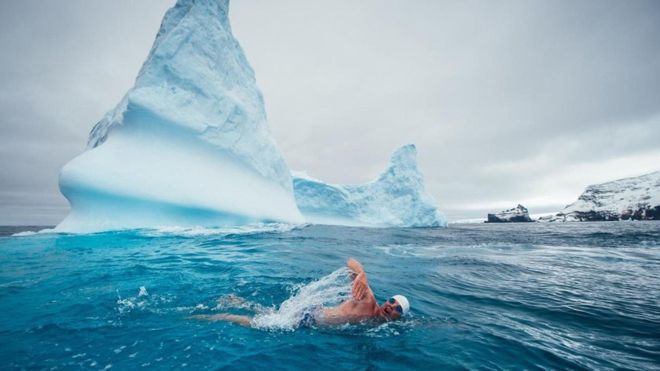
从太空俯视,很明显地球表面大部分是蔚蓝色的,世界五个大洋覆盖了地球的大部分。五大洋包括最大最深的太平洋,以及最小且最浅的北冰洋。直至今日, 90%的海洋仍旧处于未被探索阶段。
这些谜一般的庞大无边的水体一直向人类发起挑战,并且将人类的忍耐力和技巧推至极限。多项不同寻常的自然纪录,以及人类许多不同凡响的成就都来自海洋。
史上最大的动物
这是最大的海洋纪录保持者。蓝鲸是已知存在过的最大生物,甚至比最强壮的恐龙还庞大。他们的体重接近200吨,身长超过30米。为了更直观起见,这种奇妙的生物身长大约相当于三辆双层巴士。
具备如此庞硕的体型,你也会期待它能创造某些其它纪录,而蓝鲸并未让人失望。一只不幸死亡的蓝鲸最近被冲到加拿大纽芬兰岛的岸上,这只蓝鲸的心脏重达180公斤,这是全世界已知最大的心脏。其主动脉(将血液从心脏传递到全身其余各部分的主要动脉血管)足够容纳一个人的头部。相比之下,人的主动脉仅容一只蚂蚁爬过。
最大的海浪
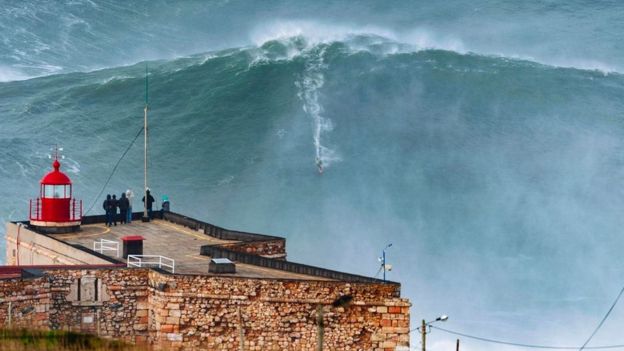
夏威夷冲浪者嘉瑞特·麦克纳马拉(Garrett McNamara)保持着冲过最大海浪的纪录(图片来源: Tó Mane)
海浪是由潮汐和水体表面的海风引起的,海浪的大小取决于海风吹多久,海风的强度以及海浪行进了多远。有史以来最高的海浪达到19米(相当于62.3英尺),是由一个浮标在北大西洋探测到的。甚至这样的巨浪也不是观测到的最高海浪,最高的海浪是由一艘船于2002年同样在北大西洋观测到的。
对于那些对海浪高度感兴趣的人来说,海浪的高度是一个浪的波峰与下一个浪波谷之间的高度差。近来冲浪的高度纪录达到了23.77米(相当于78英尺),是由夏威夷冲浪者嘉瑞特·麦克纳马拉在葡萄牙的纳扎雷(Nazaré in Portugal)于2011年创造的。他甚至在同一个地区冲过高达30米(相当于100英尺)的海浪,这一不可思议的英勇事迹可能很快就会得到官方承认。全世界仅有几处能够形成可供冲浪的巨浪的地方。像纳扎雷那样的水下狭窄峡谷这样的水下地形,对于创造绝佳的条件是非常重要的因素。
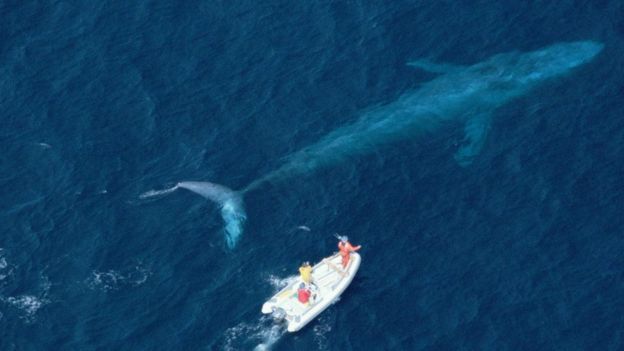
跟其庞大的体型不同,蓝鲸(blue whales)以小型虾类生物磷虾(krill)为生(图片来源: Minden Pictures / Alamy Stock Photo)
距离最长的哺乳动物迁徙
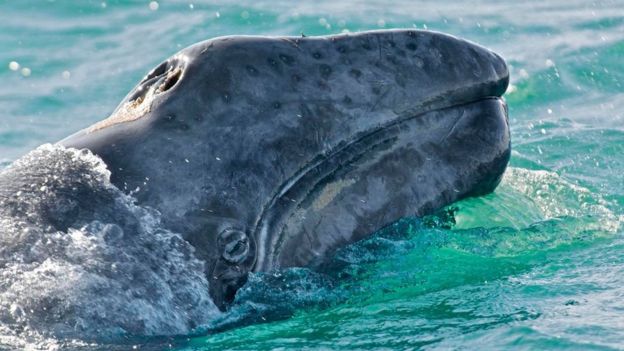
灰鲸(gray whale)创纪录的迁徙长达172天(图片来源: Mark Carwardine / naturepl.com)
非洲大平原上的角马大迁徙令人叹为观止,其迁徙里程长达3,000公里(1,800英里)。北美的驯鹿每年能够走过5,000公里(3,100英里)。但是比起灰鲸的迁徙而言,两者就像是"公园里的漫步",近来研究者发现灰鲸迁徙往返里程长达22,500公里(14,000英里),他们从位于俄罗斯东海岸的产仔地前往墨西哥,然后再折返。这也同样把座头鲸10,000公里(6,200英里)的里程挤下头名,后者是在巴西与马达加斯加之间往返迁徙。
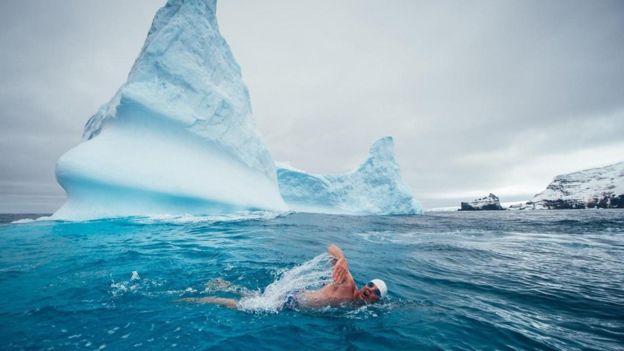
英国的耐力游泳健将刘易斯·皮尤是在世界最南端游泳这一纪录的保持者(图片来源: Kelvin Trautman)
灰鲸游过的某些水域对绝大多数人类而言寒冷异常,但是对于创造了世界最南端游泳这一记录的著名耐力游泳健将刘易斯·皮尤(Lewis Pugh)却并非如此,他在南极洲罗斯海的威尔士湾(Bay of Whales in Antarctica's Ross Sea)游了350米,那里海水的温度为零下一摄氏度(30华氏度),气温为零下37摄氏度(零下34.5华氏度)。他仅靠一条泳裤、一个泳帽和谷歌就实现了这一壮举,使得其成就显得更为非同凡响。
最长寿的动物(脊椎动物和无脊椎动物)
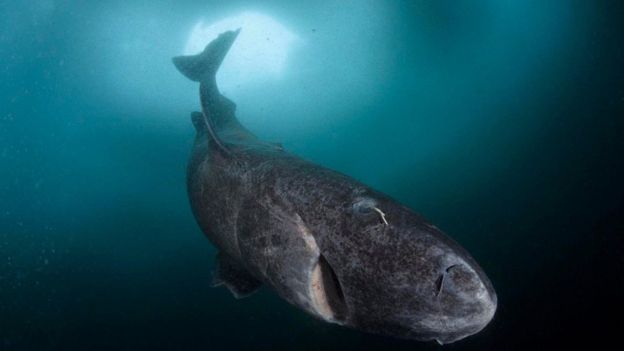
格陵兰鲨(Greenland shark)近期取代北极露脊鲸(bowhead whale)成为最长寿的脊椎动物(图片来源: Franco Banfi / naturepl.com)
像我们一样的脊椎动物拥有由软骨(cartilage)或骨头包围的脊髓(spinal cord),包括哺乳动物、鱼类、两栖类(amphibians)和爬行类(reptiles)。所有这些动物中最长寿的可以在北大西洋和北冰洋的深处找到,那就是格陵兰鲨。去年,一条母鲨被确定为大约400岁,虽然放射性碳检测推定其年龄为272-512岁之间。这意味着她是在16世纪早期至18世纪中期出生的。即便是在其推定年龄的下限,她也能够击败前任纪录保持者,一条约211岁大的露脊鲸。
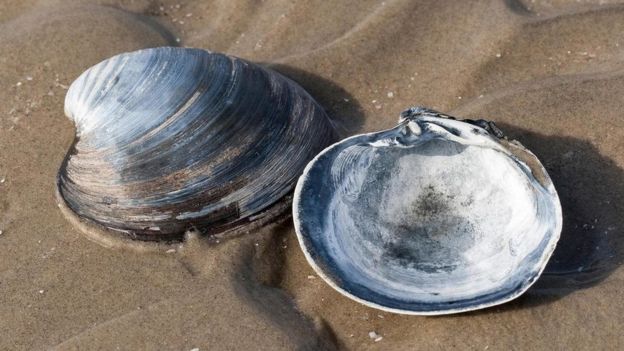
圆蛤(Quahog clam)不仅是最长寿的软体动物(molluscs),它们的贝壳厚度能够长到超过50毫米(图片来源: Frank Hecker / Alamy Stock Photo)
格陵兰鲨可能仅仅处于中游位置,这意味着她成为最年长的生物还有一定距离。最高记录属于一个叫做明的无脊椎生物,之所以叫这个名字是由于这是一个出生于中国明代年间的冰岛海岸的圆蛤。最近其年龄从405岁一下子涨到了令人叹为观止的507岁,该记录至今尚未打破。
人类依然有机会打破这样的纪录。1875年出生于法国的让娜·露易丝·卡尔蒙(Jeanne Louise Calment )是人类年岁最长者,高达122岁高龄。但是人类长寿的纪录能够大大超过这一年限,来自印尼的姆巴.戈托(Mbah Gotho)声称自己146岁高龄,虽然这尚未被证实。
速度最快的游泳者
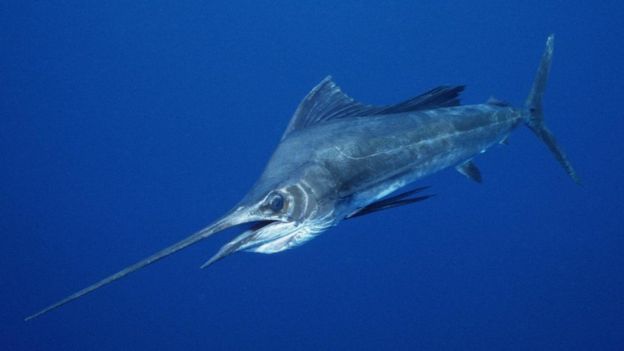
旗鱼(Sailfish)以其独特的背鳍而得名(图片来源: Doug Perrine / naturepl.com)
你能够游得多快?你可能达不到奥运游泳运动员迈克尔·菲尔普斯(Michael Phelps)的水平,他能够每小时游8公里(5英里),但是即便奥运游泳选手也无法匹敌旗鱼的速度。曾有广泛报道,旗鱼短距离的瞬间最高时速达到110公里。但是最近的研究表明,其最高时速更可能为每小时40公里(25英里)。
这依然非常之快,但是它将遇到争夺速度最快的鱼这一头衔的竞争者:黑枪鱼(black marlin)。这种强壮的鱼类被测到能够加速至时速129公里(80英里)。记录并测量这样的速度非常困难,但是这两种鱼都在争夺地球上最快的游泳者这一头衔。
地球最深处

电影导演詹姆斯·卡梅伦(James Cameron)驾驶一艘潜水器到达了地球上已知的最深处挑战者深渊(Challenger Deep)(图片来源: Imeh Akpanudosen / gettyimages)
马里亚纳海沟(Mariana Trench)位于菲律宾以东的太平洋底。这是一处位于洋底海床的深谷,是由一个地壳版块俯冲到另一个版块下方形成的,其长度超过2,550公里(1,500英里),平均宽度达到69公里(43英里)。但是其深度却无人能及,其不单单是地球海洋的最深处,同时也是地球表面的最深处。海沟最深处的挑战者深渊至洋面的深度几乎达到11,000米(36,000英尺)。
你可以将珠穆朗玛峰(Mount Everest)投到马里亚纳海沟中,而其顶峰还将在水面以下1.6公里(1英里),有数千人爬上过珠穆朗玛峰,而仅有数人曾经潜入海沟深处。其中一位是电影导演詹姆斯·卡梅伦,他曾于2012年的一次探险中搭乘一艘名为深海挑战者(Deepsea Challenger)的深潜器到达了那里。
潜水最深的哺乳动物
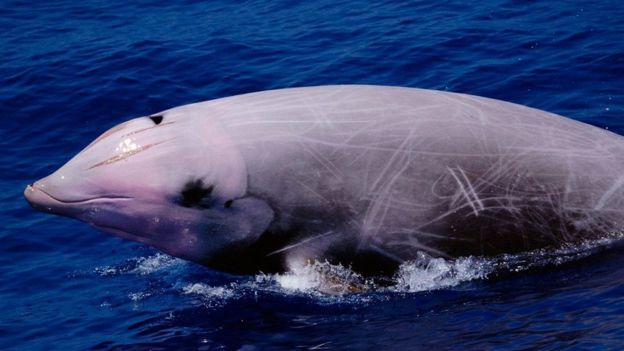
柯氏喙鲸(Cuvier's beaked whale )保持着潜水最深及水中闭气最久两项哺乳动物的纪录(图片来源: Todd Pusser / naturepl.com)
对于真正的深潜而言,柯氏喙鲸领衔成为潜水最深的哺乳动物。科学家们最近对这些鲸鱼进行追踪,并且报道其中一条潜到了2992米(9,816英尺)深处。它们还在这一过程中创下另一项哺乳动物的纪录,即一口气在水中闭气超过2小时,长达138分钟。
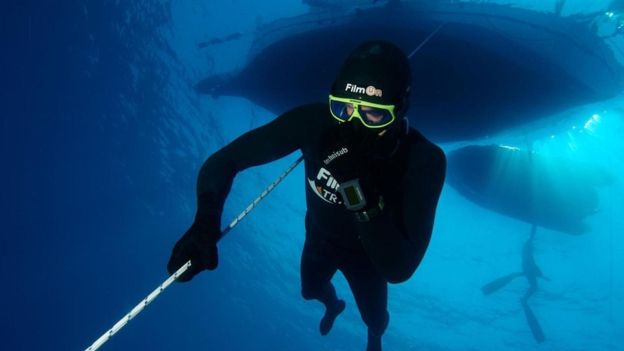
奥地利人赫伯特·尼池(Herbert Nitsch)的绰号是"地球上最深的人"(图片来源: sharky / Alamy Stock Photo)
根据使用重物、脚蹼和绳子的不同,有几项不同的人类自由潜水纪录(不带氧气瓶的闭气潜水)。最深的自由潜水能够达到几百米深处,而当赫伯特·尼池首次创下214米(702英尺)的无限制类别的潜水纪录时,他赢得了"地球上最深的人"的绰号。
来自新西兰的威廉·特鲁布雷奇(William Trubridge)是自由潜水的世界纪录保持者,他是第一个在没有帮助的情况下打破100米潜深障碍的人。 (图片来源: Nature Picture Library / Alamy Stock Photo)
威廉.特鲁布雷奇15次打破世界纪录,并且获得多项自由潜水世界冠军。他同时保持着恒重无蹼(constant weight without fins)方式潜水潜深102米(相当于334英尺)和攀索式(free immersion)潜水潜深134米(相当于407英尺)的世界纪录。
Seven incredible ocean record breakers
Looking from space it’s obvious that much of our planet’s surface is blue, the majority of which is covered the world’s five oceans – from the largest and deepest, the Pacific Ocean, to the smallest and shallowest, the Arctic Ocean. To date, over 90% of our oceans remain unexplored.
These mysterious, super-sized bodies of water have challenged and pushed us to the limits of endurance and skill. They are the source for many impressive natural record breakers, and extraordinary human record-breaking achievements.
Largest animal ever
Ocean record breakers don’t get much bigger than this. The blue whale is the largest animal known to have existed, even bigger than the mightiest of dinosaurs. They have been known to weigh close to 200,000kg (31,494st) and reach lengths of over 30m (98.5ft). To put this into perspective, this wondrous mammal is about the length of three double decker buses.
With such gigantic proportions you’d expect some other record-breaking achievements and, again, the blue whale doesn’t disappoint. When one, which had sadly died, was recently washed ashore in Newfoundland, Canada, the heart was found to weigh 180kg (28st 4lb), making it the world’s biggest known heart. The aorta (the main artery that carries blood away from the heart to the rest of the body) was big enough to fit a human head. By comparison, an ant could crawl through a human aorta.
Biggest wave
Waves are created by tides and wind blowing over the surface of water, the size being determined by how long the wind has been blowing, its strength, and how far the wave has travelled. At 19m (62.3ft) the highest-ever wave detected by a buoy has been recorded In the North Atlantic Ocean. Even this monster is not the highest ever observed wave, which was 29m (95ft) and spotted by a ship in 2002, also in the North Atlantic.
For those interested in wave height, it is measured from the crest of one wave to the trough of the next. The wave surfing record currently stands at 23.77m (78ft) by Hawaiian surfer Garrett McNamara at Nazare in Portugal in 2011. He may even have surfed a 30m (100ft) wave in the same region, an incredible feat that may soon be officially recognised. There are very few places in the world with monster waves for surfing, as underwater features, such as the arrow-shaped canyon at Nazaré, are important factors in creating the perfect conditions.
Longest migration by a mammal
The great wildebeest migration over the plains of Africa is impressive, covering almost 3,000km (1,800m). And the caribou of North America can travel up to 5,000km (3100 miles) per year. But both of these seem like a 'stroll in the park’ for the gray whale, which researchers recently discovered made a round trip of 22,500km (14,000 miles) as they travel from the east coast of Russia to breeding grounds off Mexico and then back again. It knocked the humpback whale's migration journey of 10,000km (6200 miles) from Brazil to Madagascar off the top spot.
Some of the waters these whales traverse are very cold – too cold for most humans – but not for renowned endurance swimmer, Lewis Pugh, who set the world record for most southerly swim. He swam 350m (1,150ft) in the Bay of Whales in Antarctica’s Ross Sea, where the water temperature was -1C (30F) and air temperature of -37C (-34.5F). A feat all the more remarkable because he did it in only a pair of trunks, cap and googles.
Oldest living animals (vertebrate and invertebrate)
Vertebrates like us have a spinal cord surrounded by cartilage or bone and include mammals, birds, fish, amphibians and reptiles. And the longest-lived of them all can be found in the depths of the North Atlantic and Arctic Oceans: the Greenland shark. Last year a female was determined to be around 400 years old, although radiocarbon dating put her age between a ‘young’ 272 years and a respectably ‘old’ 512 years old. This means she was born between the early 1500s and mid-1700s. Even at the lower end of the range it still beats the former record-holder, a bowhead whale that was an estimated 211 years old.
Her age was most likely in the middle of the range, which means she was still a few years off becoming the most aged animal. That record belongs to an invertebrate called Ming, so called after the ruling dynasty of China during which it was born, a quahog deep-sea clam from the coast of Iceland. Recently its age had been increased from 405 years old to an impressive, and yet unbeaten, 507 years old.
We still have a way to go to beat these records. At 122 years, Jeanne Louise Calment is the oldest any human has lived – she was born in France in 1875. But the record for our longevity could be pushed beyond this, as Mbah Gotho from Indonesia claims to be 146 years old, although this remains unverified.
Fastest swimmers
How fast can you swim? Probably not as fast as Olympic swimmers such as Michael Phelps, who swims at around 8km per hour (5mph), but even these guys can’t get anywhere near the speeds to match a sailfish. It has been widely reported that sailfish can reach short bursts of speeds of about 110km per hour (68mph), as measured when leaping. But recent research suggests it’s more likely to be around a maximum of 40km per hour (25mph).
That’s still fast, but there may be another contender for the title of fastest fish: the black marlin. This mighty fish could potentially have been recorded accelerating at 129km per hour (80mph). It’s very difficult to accurately record and measure these speeds, but both fish are in the race for fastest swimmers on the planet.
Planet’s deepest point
In the Pacific Ocean, east of the Philippines, lies the Mariana Trench. It’s a valley in the ocean floor formed when one tectonic plate moves beneath another one, and is more than 2,550km (1,500 miles) long and 69km (43 miles) wide on average. But it is its depth that makes it is truly outstanding, because not only is it the deepest part of the Earth's oceans, it holds the record for the deepest known point on Earth's surface. The distance between the trench’s deepest point at Challenger Deep and the the surface of the ocean is almost 11,000m (36,000ft).
You could drop Mount Everest into the Mariana Trench and its peak would still be over 1.6km (one mile) underwater, and where thousands of people have climbed Everest, only a very few have plunged the trench’s depths. One of whom was film director, James Cameron, in a deep-diving submersible called Deepsea Challenger during an expedition in 2012.
Deepest diving mammal
When it comes to really deep-diving, Cuvier's beaked whales lead the pack, setting the world record for deepest diving mammal. Scientists recently tracked these whales and reported one having dived to depths of 2,992m (9,816ft). Setting a second mammalian record in the process, that of staying underwater without taking a breath for more than 2 hours at 138 minutes.
There are a number of different human freediving records (diving without oxygen tanks and the diver relying on holding their breath), depending on the use of weights, fins and ropes. The deepest human free dives go down a few hundred metres, and when Herbert Nitsch first set the no limits category record at 214m (702ft), the Austrian earned the nickname of ‘deepest man on earth’.
William Trubridge is a 15-time world record holder and a multiple freediving world champion. He holds both the constant weight without fins record at 102m (334ft) and the free immersion record at 124m (407ft).